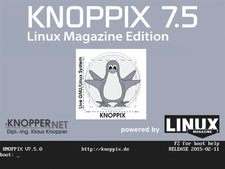Knoppix 7.5
Live Linux

Knoppix 7.5 is based on the current development version of Debian GNU/Linux and comes with hardware support from kernel 3.18 including many updates and new features.
The DVD in this month's issue is the exclusive Linux Magazine Edition of Knoppix 7.5, released in conjunction with the CeBIT 2015 Exhibition and Conference for IT and Digital Business in Hannover, Germany. This newest release from Klaus Knopper incorporates a number of new features, including kernel 3.18.6, Xorg 7.7 with core server 1.16.2 for hardware support, a custom SysVinit package for boot up, a small 12MB "boot only" CD ISO for those who cannot boot from a USB flash drive, a menu entry for the ClamAV scanner, the Knock kernel patch, an SSH server and client with TCP Stealth support, a number of new packages, and updates to standard software.
Debian systemd
Although you can find reasons for and against the use of systemd, the decision made by the Debian team to change the default boot system, along with tight integration by systemd of many system services, has greatly increased the complexity of system startup and made adjustments to the process difficult, especially when compared with the relatively primitive SysVinit.
The boot system in Knoppix, essentially comprising a single startup script for hardware detection and parallel launching of critical system components (knoppix-autoconfig) remains the same because it has its own SysVinit package. Systemd's own SysV replacement is not used in Knoppix, although the other systemd components are installed to resolve dependencies. This means that Knoppix boots up the same way it always has, unlike the Debian base since "jessie".
[...]
Buy this article as PDF
(incl. VAT)
Buy Linux Magazine
Subscribe to our Linux Newsletters
Find Linux and Open Source Jobs
Subscribe to our ADMIN Newsletters
Support Our Work
Linux Magazine content is made possible with support from readers like you. Please consider contributing when you’ve found an article to be beneficial.

News
-
Parrot OS Switches to KDE Plasma Desktop
Yet another distro is making the move to the KDE Plasma desktop.
-
TUXEDO Announces Gemini 17
TUXEDO Computers has released the fourth generation of its Gemini laptop with plenty of updates.
-
Two New Distros Adopt Enlightenment
MX Moksha and AV Linux 25 join ranks with Bodhi Linux and embrace the Enlightenment desktop.
-
Solus Linux 4.8 Removes Python 2
Solus Linux 4.8 has been released with the latest Linux kernel, updated desktops, and a key removal.
-
Zorin OS 18 Hits over a Million Downloads
If you doubt Linux isn't gaining popularity, you only have to look at Zorin OS's download numbers.
-
TUXEDO Computers Scraps Snapdragon X1E-Based Laptop
Due to issues with a Snapdragon CPU, TUXEDO Computers has cancelled its plans to release a laptop based on this elite hardware.
-
Debian Unleashes Debian Libre Live
Debian Libre Live keeps your machine free of proprietary software.
-
Valve Announces Pending Release of Steam Machine
Shout it to the heavens: Steam Machine, powered by Linux, is set to arrive in 2026.
-
Happy Birthday, ADMIN Magazine!
ADMIN is celebrating its 15th anniversary with issue #90.
-
Another Linux Malware Discovered
Russian hackers use Hyper-V to hide malware within Linux virtual machines.

